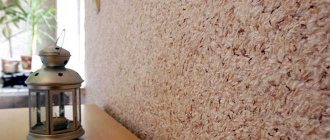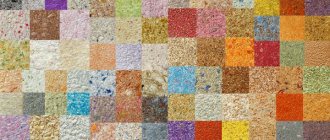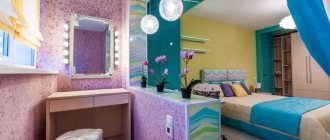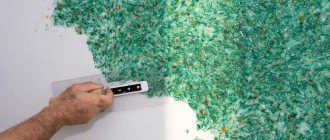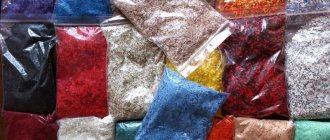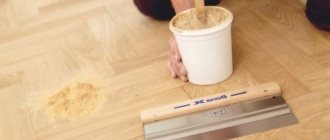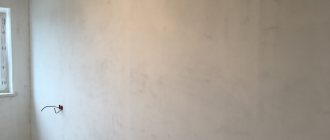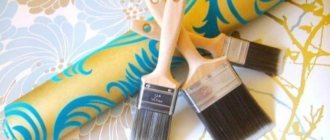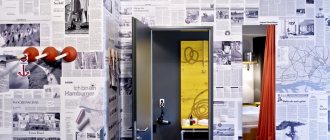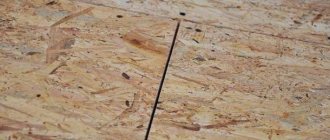The Hellenes and ancient Greeks were right when they believed that cleansing the body should take place in places that please the soul, so I wonder whether liquid wallpaper for the bathroom will cope with a similar task. Those who are already a little familiar with silk plaster (another name) know that this material is water-resistant. Is it possible to reconcile them with water, how can this be achieved?
Is it possible to apply liquid wallpaper to the bathroom?
Even a very tiny bathroom has different humidity conditions in different zones. There are areas of the walls that are in direct contact with water, and there are areas where the humidity of the surrounding air periodically increases. Vapors tend to condense on the ceiling and on cold surfaces.
In addition to humidity conditions, there are temperature conditions. Temperature fluctuations are more common in the bathroom. Liquid wallpaper in the bathroom is not as bad as dampness.
A prerequisite for finishing materials used in bathrooms is the possibility of high-quality cleaning. To put it simply, washability. It will not be possible to wash silk plaster without a varnish coating. The only thing you can do is remove dust with a vacuum cleaner with a soft bristle brush. Dampness and warmth are conditions for the successful functioning of fungus, mold, and various microorganisms. All this is not in favor of liquid wallpaper mixtures.
If you can’t do it at the same time, but you really want to, then the problem can be solved in two ways:
- using a protective coating - varnish film;
- applying liquid wallpaper in areas of the least possible moisture.
In both cases, not any of the existing compositions are used, but only moisture-resistant ones.
Silk plaster can be used in the bathroom if it is varnished. Then the walls will become more cheerful, although the coating will lose several advantages at once:
- maintainability;
- vapor permeability;
- velvety softness of the surface;
- ease of removal;
- ability to regulate microclimate.
There are messages on forums reporting that liquid wallpaper (if it is pasted outside the area of contact with water) behaves well in bathrooms. Yes, they absorb vapors from the air, but they do not slide off the walls or fall off. When the humidity in the room drops, they release the accumulated moisture.
It turns out that if you take precautions, you can use liquid wallpaper to decorate your bathroom.
Compound
In terms of appearance and method of application, liquid wallpaper looks like ordinary paint or plaster. This is where the similarities, in principle, end, because their purpose and final result differ significantly. This material is sold in specialized stores in plastic packaging and looks like dry powder. Its composition is very heterogeneous, as it contains many different substances. Here you can find cellulose, mica, wood chips, cotton particles, dyes and other components.
All of them help ensure high-quality application, reliable adhesion of the material to the wall surface, and also give the material an attractive appearance and a pleasant aroma. The presence of a cellulose component ensures the stickiness of liquid wallpaper. In addition, depending on the specifics of the material, dried seaweed can also be added there, which gives the wallpaper its own special smell, which is pleasant to humans.
Moisture-resistant liquid wallpaper for the bathroom
Let's briefly look at the composition of silk plaster. The main component of the dough is fibers of artificial substances or natural origin. They are connected to each other and to the base by adhesive substances. To decorate the coating, decorative inclusions are added - shavings, quartz grains, mother of pearl, glitters; to impart the desired properties - functional additives, for example, antifungal substances.
In total, several types of silk plaster are produced, distinguishing them by the material of the fiber raw material:
- cotton (the raw materials for the filler are cotton fibers);
- silk (mainly viscose fibers and a small proportion of silk threads);
- paper (or sawdust - cellulose fibers);
- combined (cotton-silk or cotton-paper).
Of all types of fibers, the most hygroscopic are cellulose fibers, the least are viscose and silk threads. It is from the latter that moisture-resistant compounds are produced.
About freedom of choice and the benefits of wallpaper
The toilet and bathroom are places where a person spends relatively little time. But it is their finishing and design that is given special importance. A correctly designed place for performing natural needs from an aesthetic and physiological point of view helps a person throughout the whole day. Doctors believe that visiting the toilet promotes good health if it is comfortable and cozy. A person improves the process of digestion and metabolism if he does not feel any discomfort, removing toxins and waste from the body.
Everyone has the right to decorate a bathroom in their own home in the way they consider most comfortable and convenient, but the familiarity of an established interior can sometimes be depressing. That is why renovations in an apartment begin with the bathroom and often end there due to lack of time.
It is no secret that with the development of modern innovative technologies, repairs in the 21st century are acquiring other, more advanced and technological forms, offering people more and more new materials and techniques for performing work.
Liquid wallpaper is one of the favorite new products that has been appreciated by consumers.
This environmentally friendly cellulose mixture leaves no one indifferent: it looks luxurious on the walls and creates an interior for every taste. And material costs are minimal.
Advantages and disadvantages
As a finishing material for the bathroom, silk plaster attracts with the following properties:
- hygroscopicity of the coating, allowing the walls to “breathe”, as a result of which wall materials are less destroyed over time (the advantage is lost when varnishing);
- the coating reacts little by expansion to temperature fluctuations and can withstand heating above +60°C;
- the ability to hide small relief flaws in walls;
- the ability to create a seamless finish;
- antistatic (static charges do not accumulate on the surface and do not attract dust);
- low attractiveness for mold, microorganisms, fungus;
- environmental friendliness, the ability to regulate the microclimate;
- maintainability, ease of restoration;
- scanty absorption of odors;
- universal decorative qualities (the ability to create an interior of any style, use different techniques);
- good compatibility with other finishing materials;
- visual comfort (the finish is pleasing to the eye);
- quick completion of finishing work, feasible for non-professionals.
Among the shortcomings, the first place is the price. The price of a package of mixture is comparable to that of expensive decorative plaster. Liquid wallpaper masses are not as resistant to water as plaster or tiles. It is difficult to apply the dough to walls made of brick or wood.
Another problem is the slight difference in the color shade of dry materials and the impossibility of accurately repeating the color when tinting the base test. This leads to the appearance of visible joints between the masses of the two batches. The problem is solved by simultaneously mixing two or three bags of dry mixture, that is, preparing (with a reserve) a mass of one color. Fortunately, the material does not deteriorate in its kneaded form for 5 days, and in a dried (in reserve) state for a long time. To prevent the appearance of visible joints, the mass is applied without interruption until the entire area of the wall is filled.
The remaining dough is spread in a thin layer on film, dried, and stored in an airtight package. Such remains are suitable for local repairs. They are soaked, mixed by hand, and used for “patches.”
In order not to expose silk plaster to soaking, place it in the bathroom away from the sink, bathtub or outside the shower stall. Where water gets on the wall, tiles or other waterproof finishing materials are used for finishing.
Other decorative possibilities
The variety of available decor options is one of the main advantages that liquid wallpaper has. When using ordinary materials, we simply glue what we chose in the catalog. And liquid material provides almost endless possibilities. You just need to decide which colors to use in the decoration.
- Using one color for interior decoration is the simplest and most affordable solution. If you get tired of the shade, it can be easily diluted with bright colors. Mosaics, stickers, a new mixture - there are really many options;
- You can purchase a composition of one color and then colorize it. An excellent solution for creating a bright, unusual interior in the bathroom;
- Various techniques are used to apply liquid wallpaper. Thanks to this, you can create paintings or patterns, geometric shapes. The main thing is to take care in advance of marking the contours of these figures. And then fill them in the appropriate way. The material can be easily washed off with water where the contours are unclear. This allows you to correct inaccuracies;
- The decor and effect of stucco molding is created using structural, relief rollers. Why apply two layers, one after the other. First comes the thin one, and the next one has more thickness.
How you can make a thematic pattern in the bathroom from liquid wallpaper is shown in the photo:
Selection rules
When choosing which liquid wallpaper to purchase for the bathroom, refer to the recommendations of the experts.
They advise:
- Check the packaging for markings indicating increased moisture resistance of the mixture. All branded products are of guaranteed quality, so moisture-resistant mixtures are supplied not only with information about the composition, but also with additional information about their features. If the seller assures about qualities that are not shown by the manufacturer, the product may turn out to be counterfeit.
- Select the most suitable type of mixture base. Intensely swelling cellulose masses are not suitable for rooms with a high moisture content in the air. Cotton blends occupy an intermediate position. Silk compounds are the most waterproof. It is more rational to use the latter for finishing. If the budget does not allow purchasing such mixtures, you can use combined compositions (cotton-silk).
- The decorative properties of liquid wallpaper are most evident when viewed from a certain distance. Up close they are lost, and the viewer can only see a mixture that resembles porridge. Therefore, they are not suitable for decorating small spaces. In order for silk plaster to fully fulfill its decorative function in such a room, the size of the finishing area should be small, and the area itself should be furthest away from the bathroom. Therefore, it is rational to decorate only one wall with liquid wallpaper.
- It is better to think about the color and texture of silk finishing in advance, taking into account its compatibility with other finishing materials. We also take into account that after the mass dries, the color will be more muted.
- If we don’t save money by making the dough ourselves, then we purchase products from trusted companies. This way we avoid unpleasant surprises.
It is not recommended to place liquid wallpaper where water gets on the walls. Even if the surface is protected with varnish, there will not be complete protection from getting wet.
Disadvantages of the material
The main disadvantage of liquid wallpaper is its impressive cost for the bulk of interested buyers. Since the material has recently made its presence known on the domestic market, many sellers are trying to assure craftsmen that one packet of the composition is enough to finish an entire wall. In fact, the consumption of the mixture turns out to be much more impressive.
Due to the difficulty of applying the material to walls, it cannot be compared with ordinary wallpaper.
To obtain the expected results, it is important to thoroughly prepare the surfaces. During work you have to act carefully, slowly and carefully
You can read more disadvantages in the article: https://www.syl.ru/article/152622/new_kak-nanosit-jidkie-oboi-na-potolok-poshagovaya-instruktsiya.
Photo of liquid wallpaper in the bathroom
Application technology
Apply the wallpaper mass in one of three ways:
- texture gun (if the surface is supposed to be uneven);
- using a spatula, trowel or grater;
- it is rolled with a roller to obtain a textured surface (the dough is made of a less viscous consistency).
Brief sequence of work:
- The dry mixture is pre-prepared by soaking it in water and standing until the glue is completely dissolved.
- The base surface is prepared.
- Only after this is done, the mass is glued, maintaining a layer thickness of no more than 0.5-0.7 cm. For a sanitary room, the minimum is 3 mm (it is not advisable to take a smaller thickness). A thicker layer will fall off more easily.
The application process is described in detail in our article.
The air temperature in the room should be above +10°C. Ventilation is allowed during application and drying of the dough. Before work, the electrical wiring is de-energized, the sockets are removed, and the ends of the wires are insulated.
Preparation
How should the walls be prepared in the bathroom? The features of the material allow gluing on surfaces with unevenness up to 2 mm and even small cracks. Larger defects are repaired with putty, removing dust.
If there is an old coating on the walls, then not all of them can be covered with silk wallpaper. For example, whitewash, peeling paint, and loose plaster coating are removed. The walls are cleaned of grease, salt, and moldy stains. Particular care is taken not to leave sources of rust. Excess hardware is removed, the remaining ones are isolated.
Dried walls are primed 2-3 times. Dry each time after priming. To prevent the base from showing through through the thinning of the dough, the base is painted to match the main color of the wallpaper.
To prevent debris and lumps of solution from getting inside, the bathtub and sink sink should be covered with film.
Preparation of liquid wallpaper
The mixture should be prepared in accordance with the manufacturer's recommendations indicated on the packaging.
Types of wallpaper for the toilet
The prevailing use of ceramic tiles for finishing domestic premises leads to the relative high cost of repairs when you want a radical change in the interior. Despite all the undeniable functionality and ease of maintaining cleanliness, expensive tiles, which are always difficult to install, force owners to leave the interior of the toilet unchanged.
Wallpaper for the toilet in the apartment is not a new or innovative solution to the problem, which is becoming increasingly used. The reason for the popularity that toilet renovation with wallpaper is gaining is the new types developed by the construction industry.
Advances in polymer chemistry, which introduces new artificial components in the creation of building materials, make it possible to use economical options where previously it was considered unprofitable.
Wallpapering in the toilet has become a trend after the emergence of new categories of wall coverings that are resistant to high humidity, mold and mildew, which were previously considered a strong argument against walls with wallpaper in functional rooms. The opportunity to create a dynamic interior for people with a relatively small budget has attracted home enthusiasts to do their own renovations.
The familiarity and simplicity of the process contributed to this to a large extent. Construction stores offer a wide range of wall coverings, among which you can get confused when choosing wallpaper for your bathroom. Of the relatively new varieties for finishing a small functional space, you can consider the following:
- ceramic, (from porcelain stoneware), with increased resistance to moisture;
- vinyl (thick, which can be washed regularly);
- non-woven (waterproof, washable, applied using special antiseptic glue);
- fiberglass, easy to paint and resistant to wear;
- liquid (special powder, which is diluted and applied to the wall using a roller).
When purchasing wallpaper, you need to study the labeling.
Manufacturers of moisture-resistant wallpaper
Among the popular manufacturers of mixtures, not only French brands stand out:
- Senideco offers over 150 types of wallpaper with visual appeal and velvety texture. The products are expensive, but high quality and stylish. The brand has established itself and occupies a strong position in the market.
- Cotex presents three collections to customers, distinguished by inclusions of minerals, “golden” threads, or in a monochromatic design. The company guarantees resistance to UV rays, ease of maintenance, durability and other properties.
- The Japanese “silk raincoat” - Silkcoat is a little behind the French, but pleases consumers no less than them.
- Russian-made Silk plaster, slightly inferior to French materials in the main indicators, guarantees resistance to moisture, sufficient strength and resistance to UV radiation.
If you have an idea to use liquid wallpaper for the bathroom, it is easily feasible, since modern compositions of silk plaster are much more tolerant of moisture than the wallpaper of the first years. If you follow the technology recommended by the manufacturers, as well as taking into account the characteristics of the room, you can combine water procedures and aesthetic needs.
How to trim external and internal corners
When processing external corners, you need to apply the mixture sequentially. This is done from the bottom up at a height of 20 cm on each side of the corner. The resulting seam must be pressed firmly and carefully sealed.
When working, the spatula must be moved gently, moving vertically. You can move in the horizontal direction only to eliminate large errors.
Processing internal corners is considered simpler. In this case, it is permissible to move in both directions. In this case, it is important to maintain the same thickness of the mortar layer, since defects in the joint area will be very noticeable.
Liquid wallpaper is an excellent solution for the bathroom. They fit perfectly into any interior, allowing you to implement even the most complex design ideas.
